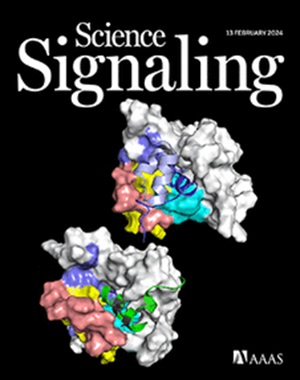RIPK3 coordinates RHIM domain–dependent antiviral inflammatory transcription in neurons
IF 6.7
1区 生物学
Q1 BIOCHEMISTRY & MOLECULAR BIOLOGY
引用次数: 0
Abstract
Neurons are postmitotic, nonregenerative cells that have evolved fine-tuned immunological responses to maintain life-long cellular integrity, including resistance to common programmed cell death pathways such as necroptosis. We previously demonstrated a necroptosis-independent role for the key necroptotic kinase RIPK3 in host defense against neurotropic flavivirus infection. Here, we show that RIPK3 activation had distinct outcomes in primary cortical neurons when compared with mouse embryonic fibroblasts (MEFs) during Zika virus (ZIKV) infection or after sterile activation. We found that RIPK3 activation did not induce neuronal death but instead drove antiviral gene transcription after ZIKV infection. Although RIPK3 activation in MEFs induced cell death, ablation of downstream cell death effectors unveiled a RIPK3-dependent transcriptional program that largely overlapped with that observed in ZIKV-infected neurons. In death-resistant MEFs, RIPK3-dependent transcription relied on interactions with the RHIM domain–containing proteins RIPK1 and TRIF, similar to the requirements for the RIPK3-dependent antiviral transcriptional signature in ZIKV-infected neurons. These findings suggest that the pleotropic functions of RIPK3 are largely context dependent and that in cells that are resistant to cell death, RIPK3 acts as a mediator of inflammatory transcription.
求助全文
约1分钟内获得全文
求助全文
来源期刊

Science Signaling
BIOCHEMISTRY & MOLECULAR BIOLOGY-CELL BIOLOGY
CiteScore
9.50
自引率
0.00%
发文量
148
审稿时长
3-8 weeks
期刊介绍:
"Science Signaling" is a reputable, peer-reviewed journal dedicated to the exploration of cell communication mechanisms, offering a comprehensive view of the intricate processes that govern cellular regulation. This journal, published weekly online by the American Association for the Advancement of Science (AAAS), is a go-to resource for the latest research in cell signaling and its various facets.
The journal's scope encompasses a broad range of topics, including the study of signaling networks, synthetic biology, systems biology, and the application of these findings in drug discovery. It also delves into the computational and modeling aspects of regulatory pathways, providing insights into how cells communicate and respond to their environment.
In addition to publishing full-length articles that report on groundbreaking research, "Science Signaling" also features reviews that synthesize current knowledge in the field, focus articles that highlight specific areas of interest, and editor-written highlights that draw attention to particularly significant studies. This mix of content ensures that the journal serves as a valuable resource for both researchers and professionals looking to stay abreast of the latest advancements in cell communication science.
 求助内容:
求助内容: 应助结果提醒方式:
应助结果提醒方式:


